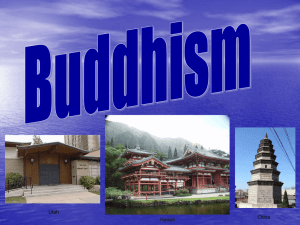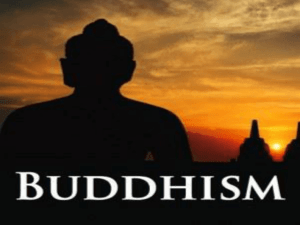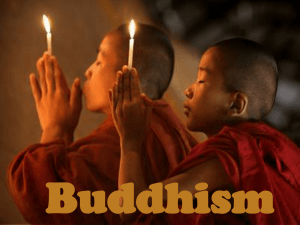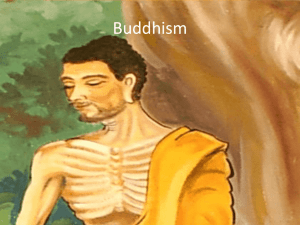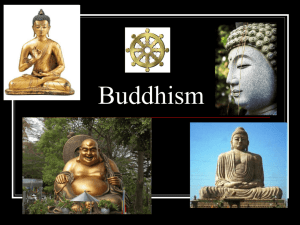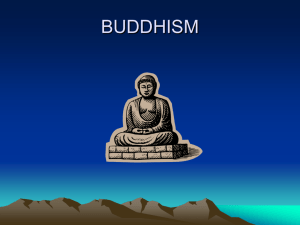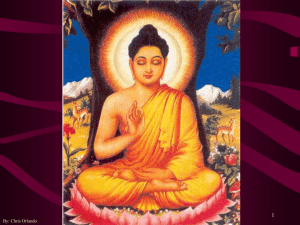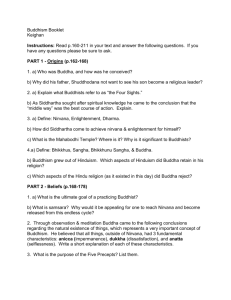Definition: Buddhism is mans attempt to escape pain and suffering
advertisement
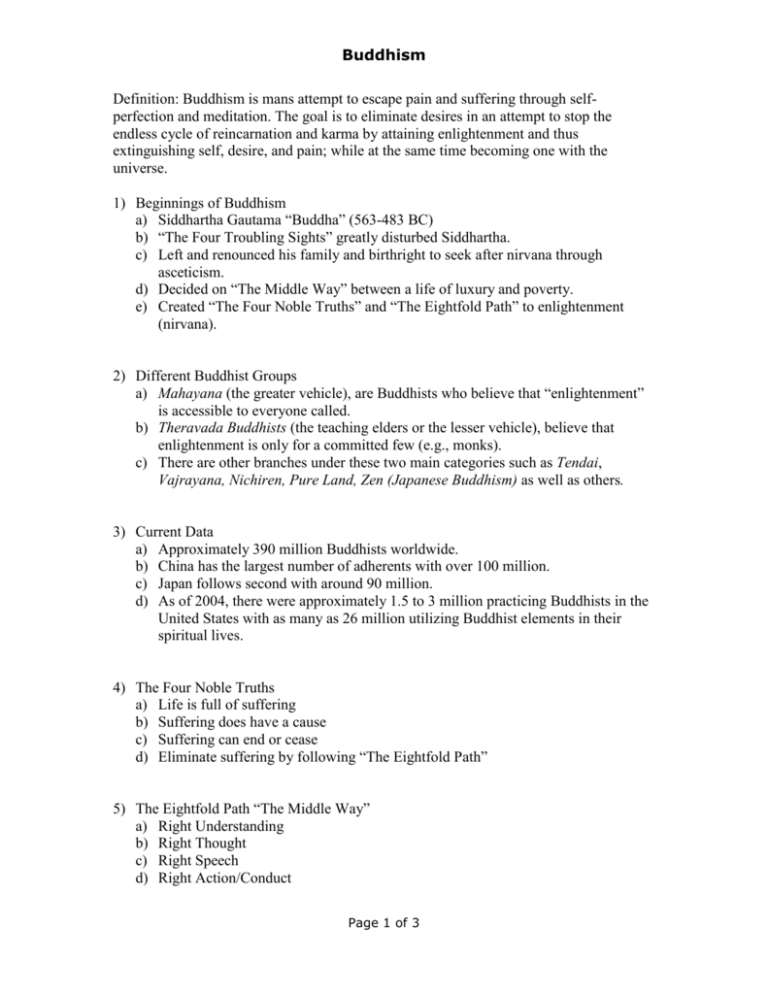
Buddhism Definition: Buddhism is mans attempt to escape pain and suffering through selfperfection and meditation. The goal is to eliminate desires in an attempt to stop the endless cycle of reincarnation and karma by attaining enlightenment and thus extinguishing self, desire, and pain; while at the same time becoming one with the universe. 1) Beginnings of Buddhism a) Siddhartha Gautama “Buddha” (563-483 BC) b) “The Four Troubling Sights” greatly disturbed Siddhartha. c) Left and renounced his family and birthright to seek after nirvana through asceticism. d) Decided on “The Middle Way” between a life of luxury and poverty. e) Created “The Four Noble Truths” and “The Eightfold Path” to enlightenment (nirvana). 2) Different Buddhist Groups a) Mahayana (the greater vehicle), are Buddhists who believe that “enlightenment” is accessible to everyone called. b) Theravada Buddhists (the teaching elders or the lesser vehicle), believe that enlightenment is only for a committed few (e.g., monks). c) There are other branches under these two main categories such as Tendai, Vajrayana, Nichiren, Pure Land, Zen (Japanese Buddhism) as well as others. 3) Current Data a) Approximately 390 million Buddhists worldwide. b) China has the largest number of adherents with over 100 million. c) Japan follows second with around 90 million. d) As of 2004, there were approximately 1.5 to 3 million practicing Buddhists in the United States with as many as 26 million utilizing Buddhist elements in their spiritual lives. 4) The Four Noble Truths a) Life is full of suffering b) Suffering does have a cause c) Suffering can end or cease d) Eliminate suffering by following “The Eightfold Path” 5) The Eightfold Path “The Middle Way” a) Right Understanding b) Right Thought c) Right Speech d) Right Action/Conduct Page 1 of 3 Buddhism e) f) g) h) Right Livelihood Right Effort Right Awareness Right Meditation 6) The Veneration of Buddha a) Temple of the Tooth Relic b) Rangoon, Burma boasts of the largest Buddha pagoda in the world with over 3500 idols of Buddha. c) Biblical Response – Exodus 20:1-5; Psalm 115: 3-8; Isaiah 42:8; 43:10-11; 44:6; 1 John 5:21 7) Reincarnation and Karma a) Reincarnation or samsara literally means “in the flesh” or “to come again in the flesh” and refers to the cyclical wheel of man’s soul as it passes into another body after death. b) Karma is the concept that what one sows in this life, they will reap in this or the next life. In other words, every action that this life causes, a reaction in this or the next life is inextricably woven into the “rebirth” or “successive lives on earth.” c) Biblical Response – Matthew 25:46; Hebrews 9:27; 2 Corinthians 5:8; Philippians 1:21 8) Nirvana a) Nirvana literally means “extinction”, “extinguished” or “blown out.” This is the ultimate goal of Buddhists, characterized by the extinction of craving, the cessation of suffering and the separation of ego. b) Biblical Response – John 5:24; 8:12; 2 Corinthians 2:9; 12:14; Revelation 2:7 9) Meditation a) There are many different forms of Buddhist meditation with the purpose of basically “shutting down” the mind. This can be achieved several ways by using techniques such as fasting, posture positions, breathing exercises and repetitive mantras. b) Biblical Response – Joshua 1:8; Psalm 1:2; 19:14; 48:9; 63:6; 77:12; 104:34; 119; 143:5; Matthew 6:7; 1 Peter 5:8; James 5:16 10) Jesus Christ or Buddha? a) Who is the Way? i) Buddha – “Buddhas do but point the way; work out your salvation with diligence.” Page 2 of 3 Buddhism ii) Jesus - “I am the way, the truth, and the life. No one comes to the Father except through me.” (John 14:6) b) Who offers More Hope? i) Dhammapada 211 - “Let, therefore, no man love anything; loss of the beloved is evil. Those who love nothing and hate nothing, have no fetters.” ii) The Bible – John 10:10; 14:26; Galatians 5:22-23; 1 John 4:18; Revelation 21:4 c) Who Extends Salvation? i) Buddhism teaches - The Noble Eightfold Path is the path to achieving salvation and to the end of one’s suffering. ii) The Bible – Isaiah 43:11; 45:21-22; John 4:42; Acts 4:12 d) Who is the Better Christ? i) Siddhartha Gautama, the Buddha, was a mere man who died, was cremated, buried and never rose again. ii) Jesus Christ predicted His death, burial and resurrection in order to demonstrate that He is God Incarnate (in the flesh). Matthew 12:38-40; 16:14,21; 17:23; 20:19 Mark 8:31-32; 9:31; 10:33; 14:58; Luke 9:22; 11:29-30; John 2:18-21 e) Conclusion - Not only is Jesus the only way to the Father (John 14:6), but He offers more hope than Buddha. Jesus extends salvation to the entire world (John 3:16) and He is the Christ, the Messiah, the “Lamb of God who takes away the sins of the world.” (John 1:29) Full handouts of the teaching can be found at: http://www.calvaryaurora.org/resources/apologetics/ To watch the DVD and listen to or download the MP3, go to: http://www.calvaryaurora.org/multimedia/message-archives/category/apologetics/ For questions, please contact Robby Beum at: robby@calvaryaurora.org Page 3 of 3
